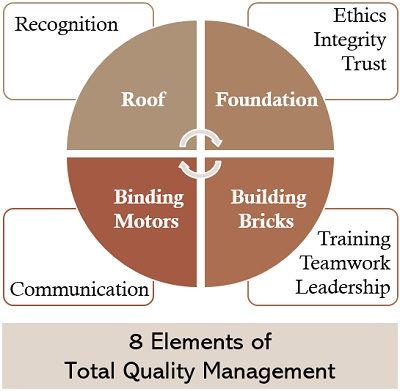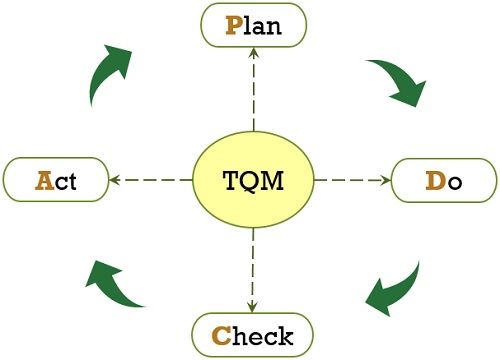Definition: Total Quality Management (TQM) is a modern production tool that is focused on providing premium consumer satisfaction through constant improvement in the organization’s processes.
In simple words, TQM is serving customers at their best by maintaining quality at each organizational level.

The total in TQM refers to all the activities undertaken toward customer satisfaction.
It includes business strategies that yield Profitability and Competitiveness. Simultaneously, it provides guidelines for making continuous improvements in the organizations.
In this concept, much stress is given to Quality Maintenance. This is because, the production of Quality goods reduces wastage and costs to a large extent.
In addition, organizations work on delivering quality performance at each management level.
Precisely, it focuses on:
- Continuous Improvement
- Employee Involvement & Empowerment
- Resource Optimization
- Reducing Errors
Managers find TQM as a scientific approach to beat the global competition. Therefore, the management takes integrated organization-wide efforts to deliver high-quality products.
Content: Total Quality Maintenance
- Scope
- Principles
- Elements
- Benefits
- Importance
- Gurus
- Steps
- Advantages
- Disadvantages
- Example
- Conclusion
Scope
As discussed above, TQM has a broader scope as it applies to all phases of the industrial cycle likes:
- Marketing
- Engineering
- Purchasing
- Manufacturing
- Mechanical
- Shipping, etc
Principles of Total Quality Management
These are the set of Rules, Procedures and Guidance for quality management. We have discussed these principles in length below:
- Customer Satisfaction:
The ultimate aim of infusing TQM is to deliver products that can meet the target customers. For this reason, firms focus on the quality of products, processes, etc. - Total Employee Involvement:
Employees are the blood of the organization. Hence, all the top to bottom-level employees works towards achieving the organizational goals. - Continuous Improvement:
Organizations need to improve continuously to survive in the long run. Therefore, it is an essential pillar of TQM that aids in fighting competition. - Strategic and Systematic Approach:
TQM is a strategic approach as it includes tactics developed by industry experts. It also contains guidelines specified by Quality Management Gurus. - Integrated System:
It integrates the efforts of all the departments. This leads to a committed workforce yielding profitability. - Fact-Based Decision Making:
It is not the hit-and-trial approach, but decision-making depends on the collected data. - Process Centered:
We call it a process-centred approach as quality control happens for every operation.
Elements of Total Quality Management
Organizations consider Eight key elements during the implementation of TQM. These elements are grouped under four heads as per their functionality.

Foundation
- Ethics
It includes discipline at the organizational and individual levels. The employees working in the organization must follow the ethics therein. - Integrity
It is the behaviour that the customers expect and deserve. Integrity covers moral values, impartiality and honesty, etc. - Trust
It is the centre of the Total Quality Management framework. Trust is an element that binds employees, organizations and customers.
Building Blocks
- Training
It is an essential element in the entire framework as it directly affects productivity. In addition, the better the training is, the more influential the quality & management will be. - Teamwork
Organizations can achieve anything with good cooperation among the employees. Thus, teamwork can help them in bringing efficiency to processes and operations. - Leadership
It is the driving force of any organization. A leader guides and motivates his team in the direction of organizational goals.
Building Mortar
- Communication
It is vital for the successful implementation of the TQM. It is the medium of connectivity between elements, stakeholders and the organization.
Roof
- Recognition
This element is important from the motivation point of view. Employees get motivated after recognition and work with more dedication.
Benefits
The application of TQM benefits the organization in numerous ways. We can classify these benefits into the following two categories:
- Customer-oriented Benefits
- Organization-oriented Benefits
Customer-oriented Benefits
- Boosts the culture of quality maintenance
- Untroubled continuous production
- Commitment to further improvement
- Improved products performance & services
- Positive customer feedback
Organization-oriented Benefits
- Decreased operating costs & losses
- Reduction in servicing costs
- Less liability exposure
- Enables the creation of a better work culture
- Provides quick solutions to various industrial production
- Increased employee participation
Importance
TQM is essential for the organization in the following ways:
- A quick fix to current problems.
- Creation of a committed and involved workforce.
- Consumer-oriented procedures and activities.
- Continuous improvements and overall growth of the Business.
- Helpful in establishing performance measures.
- Applied horizontally across the organization.
- Ensure the production of quality products.
Gurus of Total Quality Management
These are the Quality Management Gurus who contributed & formed a quality management approach.
| Shewhart | Developed Control Chart Theory of Manufactured Products |
| Ronal Fisher | Widely known as Quality Guru. Set the foundation of Design of Experiments (DOE) & Analysis of Variance (ANOVA) |
| Deming | Suggested statistical process control and is globally known as a Quality Expert |
| Juran | He emphasized Quality management at all levels |
| Feigenbaum | Given the Feigenbaum’s Quality Principles |
| Ishikawa | Developed the concept of Quality Circle & Cause and Effect diagram |
| Crosby | Introduced the thought of ‘Doing It Right The First Time' |
| Taguchi | Development of loss function |
Steps involved in Total Quality Management
PDCA Cycle or Deming Cycle includes the steps to be taken during TQM implementation. Four stages in Total Quality Management are:

P – Plan
The first step is to plan and address the issues of concern. For this, managers collect data by conducting research.
D – Do
After identifying issues, the next step is to find a suitable solution to resolve them.
C – Check
Thirdly, managers conduct a comparative analysis of changes in efficiency after applying TQM.
A – Act
If the results in the check stage are favourable, then that plan is brought to action.
Advantages
There are several advantages of implementing TQM as follows:
- Profitability:
Profitability increases by applying TQM consistently in the organization. The reason behind it is the reduction in various costs like – Scraping, Recovery and Wastage. - Increased Market Share:
The basis of this concept is the quality of products and processes. Subsequently, offering quality products to customers. Consequently, decreasing customer complaints and an increase in market share. - Reduced Wastage:
Due to the production of quality products in one go, there is a considerable decrease in defective products and resources. - Boosts Employee Motivation:
It includes the employee’s participation during the entire process. Therefore, it leads to a decrease in turnover and the creation of an engaged and motivated workforce.
Disadvantages
Following are the disadvantages as well as the obstacles in applying TQM.
- Lack of Commitment:
Industries might plan the application of TQM in the year’s beginning. But sometimes, they might fail to apply it throughout the organization. This depicts a lack of commitment from the firm’s end. - Ridged Organizational Culture:
Any kind of change is tough to implement in organizations. Consequently, the employees may not accept the changes made as per TQM. - Improper Planning:
It may turn out unsuccessful in some industries due to improper planning. Top-level management must thoughtfully plan before its application. - Lack of Training:
Improperly trained employees may not generate desired results of Quality Management. - Lack of Data and Resources:
In this, the decision-making is done based on the collected data. So, the insufficiency of data and resources may lead to misleading results.
Example
IKEA: It is a Sweden-based furniture giant in the world that applied TQM in its organization. They applied it by creating quality circles and detailed customer feedback.
Conclusion
By far, TQM is the approach that aims to achieve customer satisfaction by quality control. It is the most effective tool developed by the contribution of the Quality Management Gurus.
The companies adopting TQM in their organization are excelling in their sectors. But, there exist some obstacles to its application. Therefore, organizations must customize it as per their need.
Modiba says
Detailed information on TQM ,very much helpful to me as am on the process of studying TQM started last week with UP.
K.m.kannab says
Good clarity,